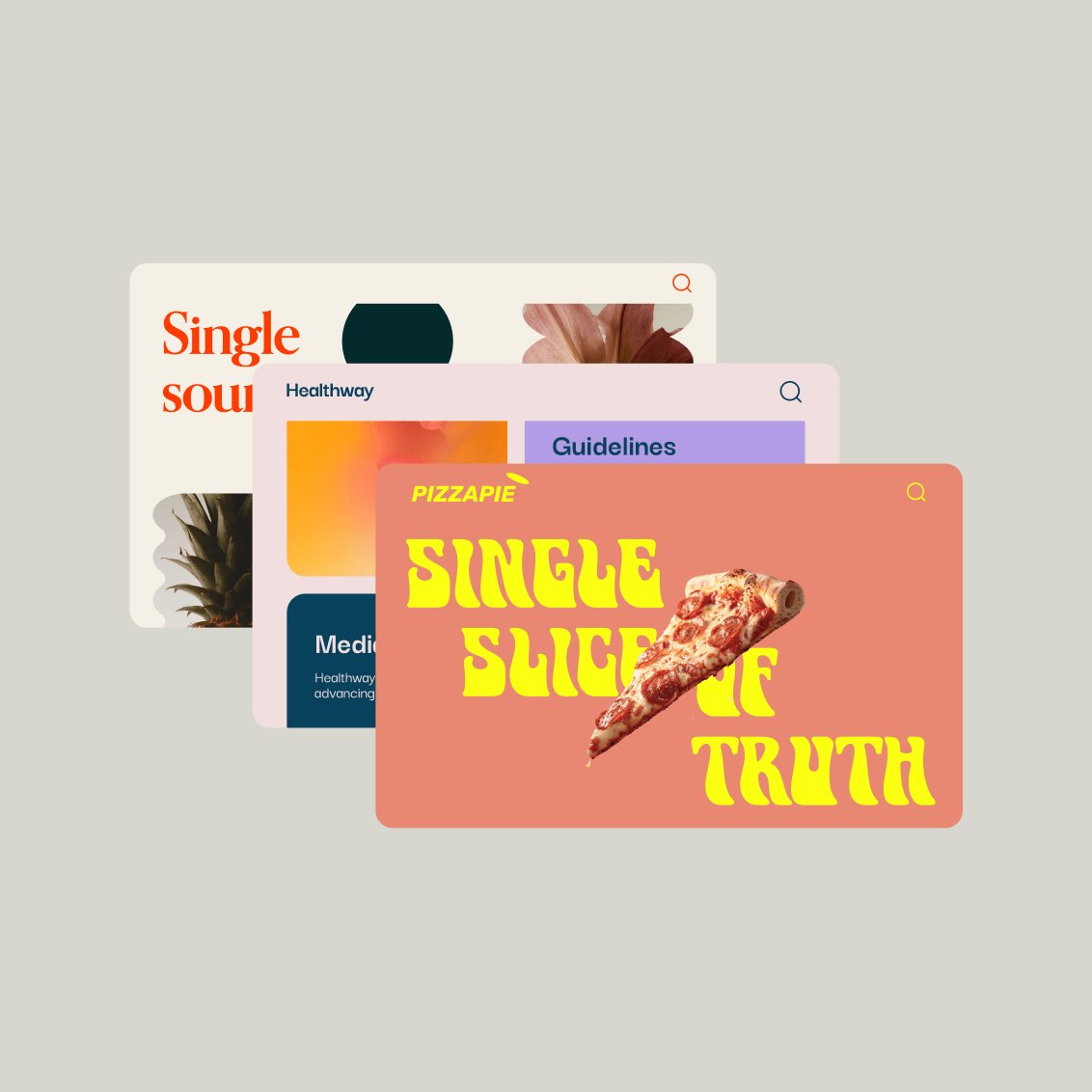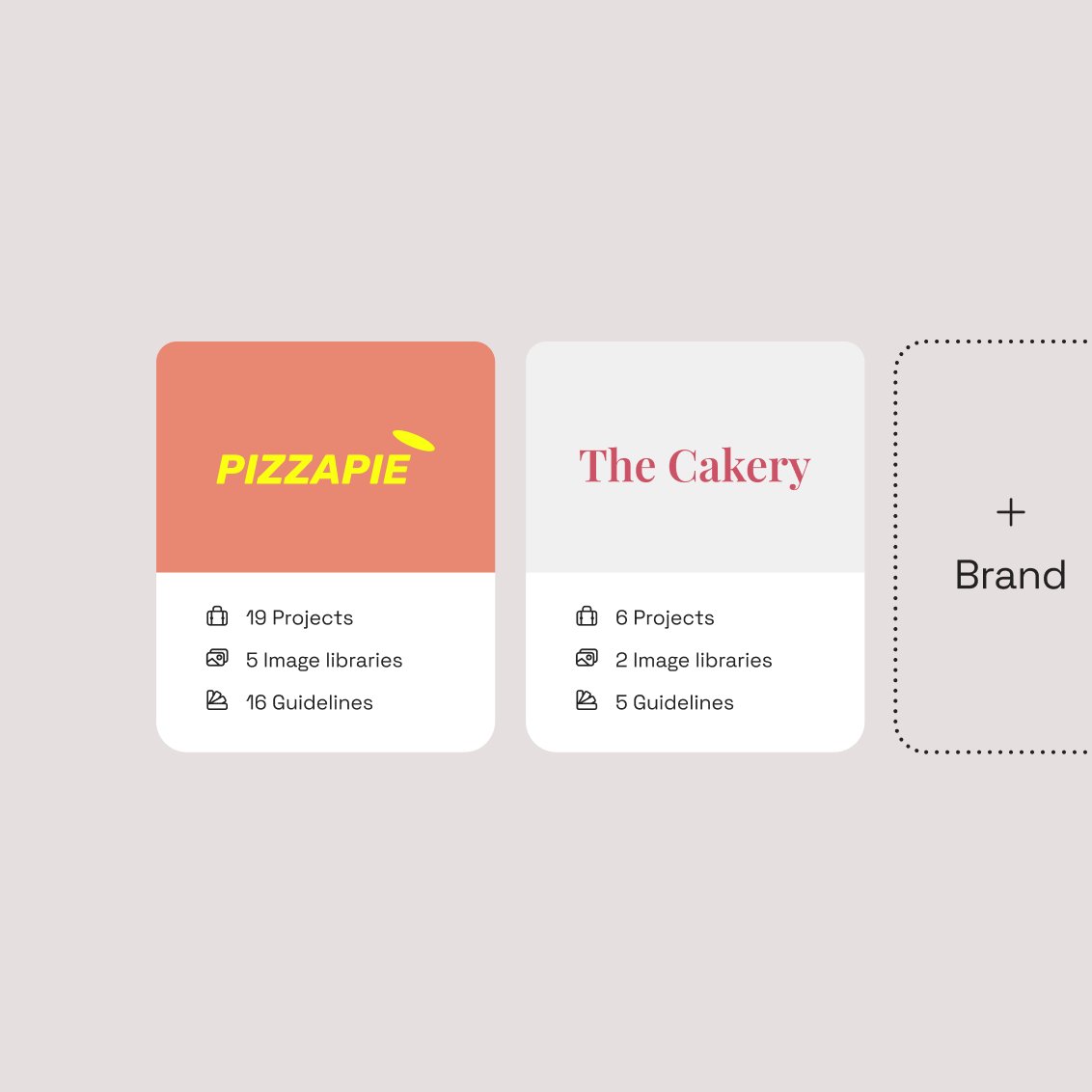Your brand shows up in so many different places — in inboxes, on social media, on product packaging, and countless other touchpoints.
But without clear guidelines and easy-to-access assets, it can quickly splinter into something unrecognizable. One designer tweaks the logo. A regional team adopts a new tone of voice. Before long, your once-cohesive brand feels disjointed and confused.
A brand kit can reduce those inconsistencies, making it easier for global, regional, and distributed teams to create company assets and marketing materials with one cohesive, recognizable brand identity. It also serves as a practical building block within a broader brand asset management strategy, helping teams govern and scale branded content more effectively.
What is a brand kit, and why does it matter?
A brand kit is a centralized collection of brand assets, guidelines, and templates that define how your brand looks and feels. It usually includes elements like your logo variations, color palette, typography, and imagery. Some companies also include approved templates for common types of brand assets such as presentations, social posts, or print materials.
Think of it as your essential branding toolbox — the brand kit should be your go-to resource for maintaining a cohesive visual identity and keeping everything on-brand. A well-crafted brand kit gives everyone, from designers to freelancers, the tools to represent your brand consistently. Without one, team members risk diluting your brand identity by using incorrect brand assets.
Brand kits are so important because they drive consistency, which helps build trust and drive recognition for your brand. They help your brand look polished and cohesive at every touchpoint, giving you a competitive edge that helps you stand out in a crowded market.

Why every business needs a brand kit
A brand kit can be a real asset to businesses, helping to save time and streamline collaboration on creative projects. Here are some of the long-term benefits they provide.
Build trust with brand consistency
For brands, even small inconsistencies like the wrong logo or off-brand tone can chip away at your credibility. When your brand looks and sounds a little different everywhere, people notice — and not in a good way.
Consistency isn’t just a design preference; it’s a trust builder. Consistent visuals and messaging signal professionalism and reliability, and build brand recognition. Whether someone visits your website, scrolls past a social media ad, opens an email, or uses your product, they should instantly recognize your brand.
A brand kit makes this consistency and repeatability scalable. It gives your team (and anyone creating on your behalf) a clear framework for visuals and messaging. They have the same tools and standards to follow, and can easily find and access high-quality, on-brand, and up-to-date marketing materials in one central place.
Increase efficiency for teams
A centralized brand kit helps teams work more efficiently. Everything in your brand kit is organized, approved, and ready to use. And all your essential brand elements are saved in one location, so team members can find the files they need quickly.
It boosts efficiency by reducing repetitive questions, long email threads, and guesswork, so team members save time they’d otherwise spend searching for specific assets, waiting for email responses, or correcting off-brand materials. It gives people the clarity and confidence to move quickly without compromising quality.
For example, a freelancer working on a creative project for your team can use your brand kit to instantly access your logos, color palettes, typefaces, and a couple of templates for similar assets, without spending hours emailing back and forth and waiting for your team to come back to them.
Support global and remote teams
For brands operating across borders or time zones, keeping everyone aligned gets tricky fast. Regional teams need the flexibility to localize content, but they also need guidance to ensure they stay on-brand.
A digital brand kit gives them just that. It acts as the single source of truth for teams everywhere, giving remote and regional teams instant access to the same brand elements and information. They can move fast without compromising the brand’s integrity, ensuring everything they produce aligns with your brand’s visual identity.
For example, the design team in your New York HQ can use the same materials as a marketer in your Berlin office, or a partner agency in Tokyo. Everyone has access to the same design elements, follows the same guidelines, and uses the same tone of voice. Plus, a brand kit removes the bottleneck of HQ being the gatekeeper for every asset request, helping regional teams work more effectively too.
Reduce errors and miscommunication
A brand kit acts as a single source of truth for your creative teams and brand stakeholders, eliminating the gray areas that often lead to mistakes or inconsistencies. Teams know exactly which logo to use, what brand colors to use in their presentation, and what the company boilerplate copy should say, meaning there’s fewer errors all round.
A brand kit gives marketing, creative, and leadership teams their reference “bible” when reviewing visual assets, meaning less feedback around whether something is on-brand. Approvals go faster, revisions drop, and quality improves across the board.
Core elements of a successful brand kit
A successful brand kit should contain your most frequently-used brand elements, as well as information to help team members use them correctly. Frontify has helped leading global companies build and manage their own brand kits, and drive brand awareness and adoption across their businesses. These are the most common elements we’ve seen companies include in their brand kits.
Logos and usage rules

Brand colors
You should document your brand colors in your brand kit. Include Pantone, RGB and HEX codes to ensure team members use the correct colors for print, online, and digital brand materials. Make it easy for team members to use these brand colors by adding downloadable color swatches to your brand kit. You may also need to provide guidance around using multiple or secondary colors — either from a branding perspective or to meet accessibility needs.

Fonts and typography
Your brand kit should include your brand fonts including downloadable font kits. You should provide guidelines on using different fonts for digital and printed materials (if needed), as well as information on using alternative fonts if your brand font is unavailable in specific tools, applications, or use cases.
Reusable branded templates
Many companies add editable templates to their brand kits. These templates are for commonly-used branded materials such as presentations, social media posts, email newsletters, and business cards. Editable templates help you scale up content production while ensuring brand consistency, as you can lock key elements like brand colors and fonts, so non-designers can create their own branded materials without introducing brand inconsistencies.

5 simple steps to build your brand kit
A comprehensive brand kit can bring real efficiency and consistency gains to your business. These five steps will help you build a brand kit to help your company realise those benefits.
1. Audit what you have
Start by reviewing your existing brand elements. Look at what you’ve already got, and what materials are missing. You may have brand elements distributed across different tools and platforms, so as well as reviewing what you have, remember to also consider where it is located and who can access it.
2. Create or document standards
Having clear rules around asset usage — like logo placement or color combinations — will help improve the consistency of your brand materials. If you have detailed brand guidelines, you can pull this information from there to add to your brand kit. If not, you should create and document those standards from scratch.
As well as providing written instructions, include visual examples alongside written guidelines to help team members see how your brand elements should (and shouldn’t) be used. For example, Trustpilot has a “Dos and Dont’s” section in its brand kit, demonstrating how to properly use its brand colors.
3. Develop editable templates
Get your designers to create editable templates for commonly-used brand assets like presentations, emails, or social media graphics. Adopt a standardized format for different asset types, so that team members can use these templates to create their own on-brand materials.
Designers can create templates that users can edit to create their own versions. Lock core brand elements like your logos, fonts, or color palettes to ensure brand consistency, then encourage team members to self serve and use the templates in your brand kit as needed. For example, Bang & Olufsen has editable, downloadable templates for common digital assets like banners, which users can download from its brand kit:
4. Centralize everything
Bring all your brand elements, standards, and templates together into one central location. Centralize everything in a brand platform like Frontify, which makes all your brand guidelines, assets, elements, and templates accessible in real-time.
Your brand kit can become the single source of truth for your most important brand materials, so team members have just one place to go to find the files they need. This reduces confusion around finding the correct assets, and improves efficiency and consistency across the business.
5. Maintain and scale
Once you’ve built your brand kit, it’s essential to review and update it as your brand evolves. Regular maintenance will help keep your brand kit relevant and ensure it remains home to your current, on-brand assets. Consider performing quarterly audits of your brand kit to ensure all your assets and guidelines remain relevant. Remove anything that’s outdated and replace it with the latest versions, to help team members keep using your brand kit.
How to scale your brand kit as your business grows
As your business grows — for example by adding new sub-brands or entering different regions and markets — your brand kit needs to evolve to support your growing brand.
Start by building a flexible framework within your brand kit that accommodates brand variations without losing your core identity. Create dedicated sections in your brand kit for each sub-brand or region. Define what elements of your brand identity are shared (like core colors and logos) versus what can be adapted locally. Use dedicated brand portals to separate assets, guidelines, and brand elements by region or sub-brand.
AI and automation can help you scale up your brand operations and manage your growing brand kit efficiently. Tools like Frontify use AI to auto-tag brand assets, review brand copy, and answer users' questions to help them find the right templates, logos, or other brand elements. This streamlines and accelerates many of the manual tasks your brand team would otherwise handle, freeing them up to focus on higher-value work.
Finally, look for ways to drive adoption of your brand kit throughout the business. It’s a fantastic resource for improving brand consistency and engagement — but only if people use it. Run regular training sessions, tutorials, or workshops to onboard new team members, refresh existing ones, and reinforce best practices. These will help people feel confident using your brand kit and all the assets and resources it contains.
Build and manage your brand kit with Frontify
A brand kit is a must-have for companies looking to achieve the levels of visual consistency needed to build a strong brand. The right tools make it easier to create and organize your brand kit, and for team members to access all the valuable assets and resources it contains. See how Frontify can be the best home for your high-impact, scalable brand kit. Book a demo today.


